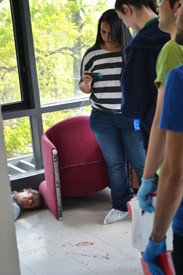Interdisciplinary seminar resonates with students, staff
The eight students surveyed the gruesome scene before them: Yellow police tape and overturned chairs; a mathematics professor lying in a pool of his own blood.
They all knew it would come to this.
It said so on the syllabus.
Moments later, classmates from the honors seminar “CrIME: Criminal Investigation through Mathematical Examination” got busy on their final exam – dusting for prints, measuring blood spatters and charting body temperatures.
“It’s the first final exam I was kind of excited about,” said Mary Nasr, 18, of Rutgers’ first mathematical forensics course. “I feel like I’m jumping into a CSI show. It’s really cool.”
Make that a CSI show crossed with a Mickey Spillane-style pulp fiction. At their May 6 exam, students received handouts with a back story about an unethical math professor clocked over the head with a wine bottle by one of the three students he double-crossed.
It was up to Nasr and her classmates, after a semester spent learning how to use mathematical concepts to solve crimes, to gather evidence and calculate which of the three fictional suspects delivered the fatal blow.
“I really like the whole mystery of solving a case,” said Nasr, a first-year animal science major from Staten Island, N.Y.
The interactive, interdisciplinary seminar is the brainchild of Eugene Fiorini, associate director of the Center for Discrete Mathematics and Theoretical Computer Science (DIMACS). Fiorini’s area of expertise in mathematics is graph theory. But it was his love of learning and applying mathematics to everyday that life led him to explore his field’s forensic applications.
“No matter how many times I go over something, or how often I teach a course, there always seems to be some new revelation or way of looking at things,” said Fiorini, who joined the university in 2008. “In this case it is not so much the mathematics itself, but the way in which it interacts with other fields.”
Instead of focusing on one branch of mathematics, Fiorini cherry-picked a range of concepts that can be used to solve crimes. Students relied on trigonometry, calculus and vector analysis to determine ballistics and blood spatter patterns. They learned how to chart body temperature with algebraic functions, which then allowed them to determine blood alcohol level and time of death.

“Obviously, we didn’t have an honest to goodness corpse for the exam,” said Fiorini with a laugh. Instead, students took multiple temperature measurements of baked potatoes, which retain heat well.
This isn’t Fiorini’s first foray into forensics. His Rutgers seminar is based on a forensic math program he created with a former colleague at Shippensburg University. When he left the Pennsylvania school for Rutgers, he put his newfound fascination on the back burner so he could delve into his DIMACS duties. But when the honors program put out feelers for inventive math courses in 2011, Fiorini saw an opportunity to pitch the course.
It’s wound up being a big a hit with the center.
“The thing that has flattered me the most is how much the DIMACS faculty staff and administrators are into this and how supportive they’ve been,” said Fiorini.
Two DIMACS staff members asked to write the storyline for the final exam, more than a dozen of Fiorini’s colleagues lent their fingerprints and footprints, and Walter Morris, DIMACS’ unit computing manager, volunteered to play the part of the slain professor.
That Fiorini’s peers were buzzing about the seminar doesn’t surprise Matt Matsuda, dean of the School of Arts and Sciences honors program.
“I think a lot of the excitement is because it is so interdisciplinary,” said Matsuda. “It lends itself to everything from math and biology to physics, chemistry and entomology. It gives a lot of people the chance to get engaged, and it’s a classic example of learning outside the classroom.”
The dynamics of project-based learning coupled with a subject that’s familiar through popular culture made the seminar appealing to students.
Though set on being a veterinarian like her father, Nasr said Fiorini’s course leapt out at her from a Honors email she received while trying to plug a three-credit hole in her spring schedule.
“It was last on the list,” she said. “I skimmed through the email and went ‘Boring. Boring. Boring. Woah!”
But will it be available next year? As long as DIMACS and the honors department are game, so is Fiorini. But this time, he’d like to get his peers involved in more than staging a final exam.
“If I could do this again it would be interesting to see if it would be possible to collaborate with other faculty in other fields to make it a broader experience,” he said. “This time we narrowly focused on mathematical forensics. But forensics, for me at least, is really collaboration across disciplines. That would give the students a better picture of the process of examining evidence and making intelligent inferences.”